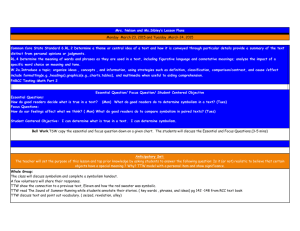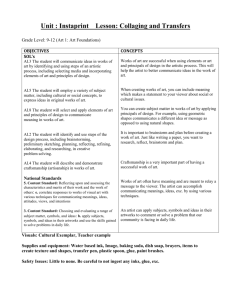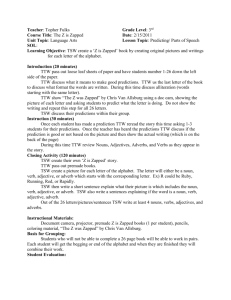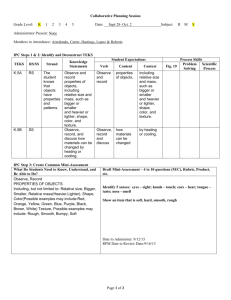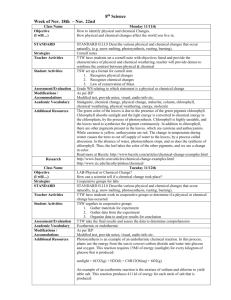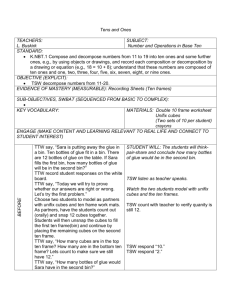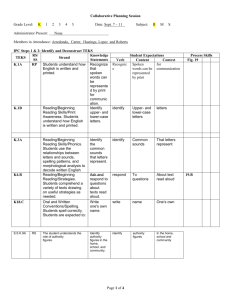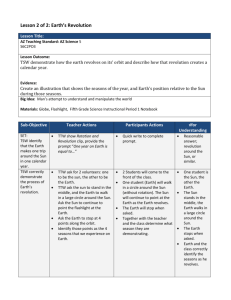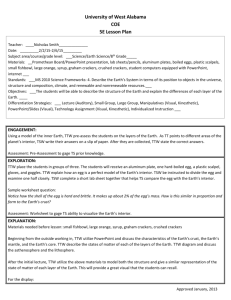File ela sept 15-19 - Judson Independent School District
advertisement
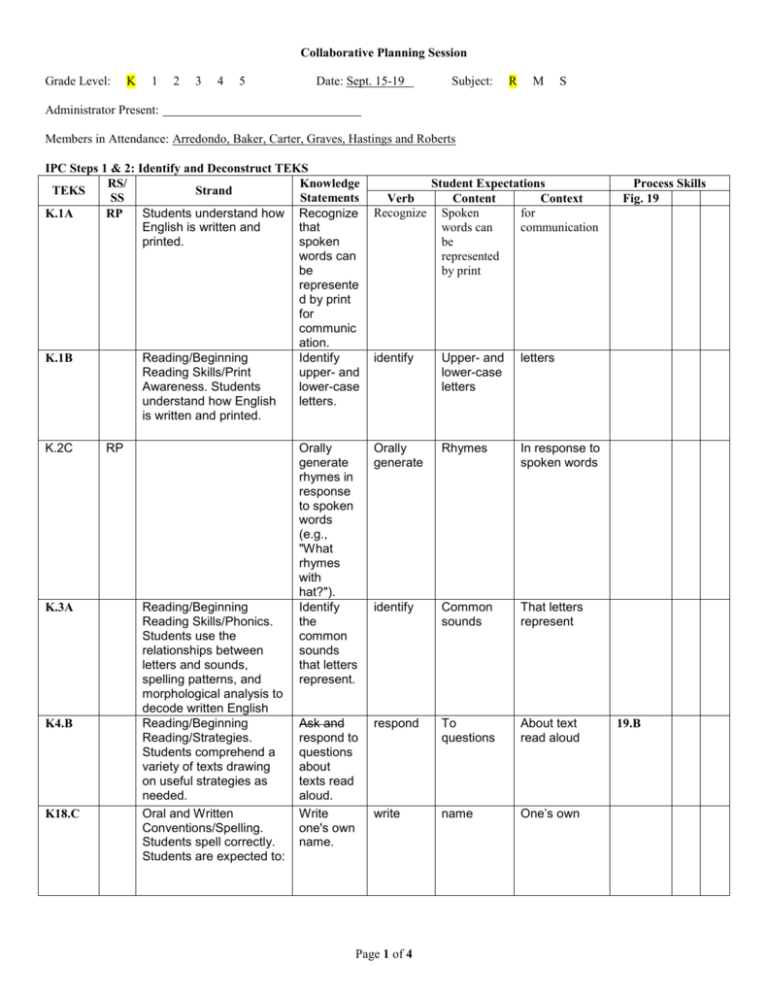
Collaborative Planning Session Grade Level: K 1 2 3 4 5 Date: Sept. 15-19 Subject: R M S Administrator Present: Members in Attendance: Arredondo, Baker, Carter, Graves, Hastings and Roberts IPC Steps 1 & 2: Identify and Deconstruct TEKS RS/ Knowledge TEKS Strand SS Statements K.1A RP Students understand how Recognize English is written and that printed. spoken words can be represente d by print for communic ation. K.1B Reading/Beginning Identify Reading Skills/Print upper- and Awareness. Students lower-case understand how English letters. is written and printed. K.2C K.3A K4.B K18.C RP Reading/Beginning Reading Skills/Phonics. Students use the relationships between letters and sounds, spelling patterns, and morphological analysis to decode written English Reading/Beginning Reading/Strategies. Students comprehend a variety of texts drawing on useful strategies as needed. Oral and Written Conventions/Spelling. Students spell correctly. Students are expected to: Verb Recognize Student Expectations Content Context Spoken for words can communication be represented by print identify Upper- and lower-case letters letters Orally generate rhymes in response to spoken words (e.g., "What rhymes with hat?"). Identify the common sounds that letters represent. Orally generate Rhymes In response to spoken words identify Common sounds That letters represent Ask and respond to questions about texts read aloud. Write one's own name. respond To questions About text read aloud write name One’s own Page 1 of 4 Process Skills Fig. 19 19.B Collaborative Planning Session IPC Step 3: Create Common Mini-Assessment What Do Students Need to Know, Understand, and Draft Mini-Assessment – 4 to 10 questions (M/C), Rubric, Product, Be Able to Do? etc. *Identify UPPER- AND LOWER-CASE LETTERS Including, but not limited to: In alphabetical sequence and random order; Consonants; Vowels *Identify THE COMMON SOUNDS THAT LETTERS REPRESENT Including, but not limited to: Identify lettersound association; Identify letters as consonants or vowels; Identify long and short vowel sounds *Write ONE’S OWN NAME Including, but not limited to: Capitalize the first letter *Speak IN COMPLETE SENTENCES TO COMMUNICATE Complete sentence – has a subject and predicate (verb or action) and expresses a complete thought (e.g., Dogs bark.) Note: Complete sentences include those that tell and ask. *Respond TO QUESTIONS ABOUT TEXTS READ ALOUD Including, but not limited to: Date to Administer: RPM Date to Review Data: Literal questions – (e.g., Who is the main character? Where is the story taking place? What is the story about?) Refer to K.Fig19B * Hold A BOOK RIGHT SIDE UP; Turn ITS PAGES CORRECTLY; Know THAT READING MOVES FROM TOP TO BOTTOM AND LEFT TO RIGHT * Listen ATTENTIVELY BY FACING SPEAKERS Including, but not limited to: In formal and informal settings; Ask RELEVANT QUESTIONS TO CLARIFY INFORMATION Including, but not limited to: Ask literal questions (e.g., who, what, where, when, why, how) Note: Refer to K.4B for related beginning reading strategies. *PURPOSE OF RULES: establish order, provide security and provide a safe environment *Rules in home and school: Establish order: School – respect others, stay in line Provide security: School – volunteers sign in, visitors wear badges Provide a safe environment : School – don’t run in halls, practice storm drills, cross at crosswalk Page 2 of 4 Collaborative Planning Session IPC Step 4 & 5 (in brief): Identify Instructional Activities/Strategies/ Methods Day NOTES Rhyming: During morning message pick out a word from the message and have students think of rhyming words. Write them on the morning message. Writers Workshop: TTW read a book about “All About Me” and will discuss things they like eat. TSW brainstorm things they like to eat. TTW model the next page of the “ME portfolio” by drawing a picture of something they like to eat and labeling it. TSW complete their next page in their “Me portfolio”. I can recognize that words can be represented by print by labeling their favorite foods. MON. Daily Five: Introduce Read to Someone. TSW predict what that means and what that would look like. TTW ask the question “Why do you suppose we would want to read to someone every day?” TTW make a chart “Reading Helps us…..” TSW give answers to put on the chart. TTW add that this helps us with fluency and reading skills. TTW introduce EEKK (elbow, elbow, knee, knee). (See Focus Lesson pages 63-66 in Daily 5 book). Teacher will have students model. TSW pair up with a buddy and practice Read to Someone. After the class is finished, TSW complete a “Read to Someone” chart adding Check for Understanding. I Can Read to Someone by looking at pictures or reading the words of a book. Focus Lesson: Introduce Letter E. TTW introduce the sound and the strokes for handwriting letter E. TSW skywrite the letter E and practice the sound. TTW introduce E Every Morning Eloise…poem to class. Have students find all the ‘e’s they see in the poem. They will also point out the rhyming words. I can identify upper- and lower-case letters and the common sounds that letters represent by skywriting the letter E and produce the /ĕ/ sound. Rhyming: During morning message pick out a word from the message and have students think of rhyming words. Write them on the morning message. Writers Workshop: TTW read a book about “All About Me” and will discuss their favorite things to do. TSW brainstorm things they like to do. TTW model the next page of the “ME portfolio” by drawing a picture of something they like to do and labeling it. TSW complete their next page in their “Me portfolio”. I can recognize that words can be represented by print by labeling something they like to do. TUES. Daily Five: Review Read to Someone. TSW predict what that means and what that would look like. TTW ask the question “Why do you suppose we would want to read to someone every day?” TTW make a chart “Reading Helps us…..” TSW give answers to put on the chart. TTW add that this helps us with fluency and reading skills. TTW introduce EEKK (elbow, elbow, knee, knee). (See Focus Lesson pages 63-66 in Daily 5 book). Teacher will have students model. TSW pair up with a buddy and practice Read to Someone. After the class is finished, TSW complete a “Read to Someone” chart adding Check for Understanding. I Can Read to Someone by looking at pictures or reading the words of a book. Focus Lesson: Review letter E sound and strokes. TTW review E Every Morning Eloise…poem to class. TSW illustrate 3 words that begin with the letter E in their journals. TSW brainstorm a list of words that begin with letter E. TTW make a matching anchor chart. I can identify upper- and lower-case letters and the common sounds that letters represent creating a list of words that begin with Ee /ĕ/. Rhyming: During morning message pick out a word from the message and have students think of rhyming words. Write them on the morning message. WED. Writers Workshop: TTW read a book about “All About Me” and will discuss things that make them happy. TSW brainstorm things that make them happy. TTW model the next page of the “ME portfolio” by drawing a picture of something that makes them happy and labeling it. TSW complete their next page in their “Me portfolio”. I can recognize that words can be represented by print by labeling something that makes me happy. Daily Five: Review Read to Someone. TSW predict what that means and what that would look like. TTW ask the question “Why do you suppose we would want to read to someone every day?” TTW make a chart “Reading Helps us…..” TSW give answers to put on the chart. TTW add that this helps us with fluency and reading skills. TTW introduce EEKK (elbow, elbow, knee, knee). (See Focus Lesson pages 63-66 in Daily 5 book). Teacher will have students model. TSW pair up with a buddy and practice Read to Someone. After the class is finished, TSW complete a “Read to Someone” chart adding Check for Understanding. I Can Read to Someone by looking at pictures or reading the words of a book. Page 3 of 4 Collaborative Planning Session Focus Lesson: Introduce Letter F. TTW introduce the sound and the strokes for handwriting letter F. TSW skywrite the letter F and practice the sound. TTW review E Every Morning Eloise…poem to class. TTW introduce F Five Fast Fishes…poem to class. Have students find all the ‘f’s they see in the poem. They will also point out the rhyming words. I can identify upper- and lower-case letters and the common sounds that letters represent by skywriting the letter F and produce the /f/ sound. Rhyming: During morning message pick out a word from the message and have students think of rhyming words. Write them on the morning message. Writers Workshop: TTW read Eating the Alphabet and discuss the labels in the book and what labeling is. TTW make a labeling anchor chart. For the anchor chart draw an animal such as a bear or a cat and label the parts such as ears, tail, etc. I can recognize that words can be represented by print by making an anchor chart about labeling. THURS. Daily Five Review Read to Someone. TSW predict what that means and what that would look like. TTW ask the question “Why do you suppose we would want to read to someone every day?” TTW make a chart “Reading Helps us…..” TSW give answers to put on the chart. TTW add that this helps us with fluency and reading skills. TTW introduce EEKK (elbow, elbow, knee, knee). (See Focus Lesson pages 63-66 in Daily 5 book). Teacher will have students model. TSW pair up with a buddy and practice Read to Someone. After the class is finished, TSW complete a “Read to Someone” chart adding Check for Understanding. I Can Read to Someone by looking at pictures or reading the words of a book. Focus Lesson: Review letter F sound and strokes. TTW review E Every Morning Eloise…poem to class and the F Five Fast Fishes…poem to class. TSW brainstorm a list of words that begin with letter F. TTW make a matching anchor chart. TSW illustrate 3 words that begin with the letter F in their journals. I can identify upper- and lower-case letters and the common sounds that letters represent creating a list of words that begin with Ff /f/. Rhyming: During morning message pick out a word from the message and have students think of rhyming words. Write them on the morning message. Writers Workshop: Review and assess this week’s skills and activities. I can recognize that words can be represented by print by reviewing various writing activities. FRI. Daily Five: Review Read to Someone. TSW predict what that means and what that would look like. TTW ask the question “Why do you suppose we would want to read to someone every day?” TTW make a chart “Reading Helps us…..” TSW give answers to put on the chart. TTW add that this helps us with fluency and reading skills. TTW introduce EEKK (elbow, elbow, knee, knee). (See Focus Lesson pages 63-66 in Daily 5 book). Teacher will have students model. TSW pair up with a buddy and practice Read to Someone. After the class is finished, TSW complete a “Read to Someone” chart adding Check for Understanding. I Can Read to Someone by looking at pictures or reading the words of a book. I can identify upper- and lower-case letters and the common sounds that letters represent by creating a list of words that begin with Ee,Ff /ĕ/&/f/. Focus Lesson: Review letter E and F sound and strokes. Page 4 of 4
